Real-Time Source Dynamics of PM2.5 During Winter Haze Episodes Resolved by SPAMS: A Case Study in Yinchuan, Northwest China
Abstract
1. Introduction
2. Materials and Methods
2.1. Study Area and Monitoring Sites
2.2. Monitoring Equipment
2.3. Data Analysis
3. Results and Discussion
3.1. Overview of Air Pollution During the Observation Period
3.2. Characteristics and Sources of Changes in PM2.5 Components
3.2.1. Characterization of Temporal Variation in PM2.5 Source Resolution
3.2.2. PM2.5 Refined Source Analysis
3.2.3. Characteristics of PM2.5 Source Analysis Changes Under Different Pollution Levels
3.3. Formation and Evolution of Typical Pollution Events
3.4. Analysis of Fresh and Aged Sources of PM2.5
4. Conclusions
Supplementary Materials
Author Contributions
Funding
Data Availability Statement
Acknowledgments
Conflicts of Interest
References
- Zhang, Q.; Meng, X.; Shi, S.; Kan, L.; Chen, R.; Kan, H. Overview of particulate air pollution and human health in China: Evidence, challenges, and opportunities. Innovation 2022, 3, 13. [Google Scholar] [CrossRef] [PubMed]
- He, C.; Liu, C.; Chen, R.; Meng, X.; Wang, W.; Ji, J.; Kang, L.; Liang, J.; Li, X.; Liu, Y.; et al. Fine particulate matter air pollution and under-5 children mortality in China: A national time-stratified case-crossover study. Environ. Int. 2025, 159, 107022. [Google Scholar] [CrossRef]
- Tan, T.; Zhang, G.; Liu, C.; Li, Y. Multi-year (2015–2023) trend and key factors of bioaerosols in urban atmosphere: A case study in Xi′an. Atmos. Environ. 2025, 353, 121258. [Google Scholar] [CrossRef]
- Bhatti, U.A.; Marjan, S.; Wahid, A.; Syam, M.S.; Huang, M.; Tang, H.; Hasnain, A. The effects of socioeconomic factors on particulate matter concentration in China′s: New evidence from spatial econometric model. J. Clean. Prod. 2023, 417, 137969. [Google Scholar] [CrossRef]
- Sangkham, S.; Phairuang, W.; Sherchan, S.P.; Pansakun, N.; Munkong, N.; Sarndhong, K.; Islam, M.; Sakunkoo, P. An update on adverse health effects from exposure to PM2.5. Environ. Advances 2024, 18, 100603. [Google Scholar] [CrossRef]
- Chen, S.; Liu, D.; Huang, L.; Guo, C.; Gao, X.; Xu, Z.; Yang, Z.; Chen, Y.; Li, M.; Yang, J. Global associations between long-term exposure to PM2.5 constituents and health: A systematic review and meta-analysis of cohort studies. J. Hazard. Mater. 2024, 474, 134715. [Google Scholar] [CrossRef] [PubMed]
- Beelen, R.; Hoek, G.; Raaschou-Nielsen, O.; Stafoggia, M.; Andersen, Z.J.; Weinmayr, G.; Hoffmann, B.; Wolf, K.; Samoli, E.; H Fischer, P.; et al. Natural-cause mortality and long-term exposure to particle components: An analysis of 19 european cohorts within the multi-center ESCAPE project. Environ. Health Perspect. 2015, 123, 525–533. [Google Scholar] [CrossRef]
- Sang, S.; Chu, C.; Zhang, T.; Chen, H.; Yang, X. The global burden of disease attributable to ambient fine particulate matter in 204 countries and territories, 1990–2019: A systematic analysis of the Global Burden of Disease Study 2019. Ecotoxicol. Environ. Saf. 2022, 238, 113588. [Google Scholar] [CrossRef]
- Liu, S.; Xing, J.; Wang, J.; Wang, S.; Zhang, X.; Ding, A. Understanding of aerosol–climate interactions in China- aerosol impacts on solar radiation, temperature, cloud, and precipitation and its changes under future climate and emission scenarios. Curr. Pollut. Rep. 2019, 5, 36–51. [Google Scholar] [CrossRef]
- Huang, R.; Zhang, Y.; Bozzetti, C.; Ho, K.; Cao, J.; Han, Y.; Daellenbach, K.R.; Slowik, J.G.; Platt, S.M.; Canonaco, F.; et al. High secondary aerosol contribution to particulate pollution during haze events in China. Nature 2014, 514, 218–222. [Google Scholar] [CrossRef]
- Madaniyazi, L.; Nagashima, T.; Guo, Y.; Yu, W.; Tong, S. Projecting fine particulate matter-related mortality in east China. Environ. Sci. Technol. 2015, 49, 11141–11150. [Google Scholar] [CrossRef]
- Moreno-Ríos, A.; Tejeda-Benítez, L.P.; Bustillo-Lecompte, C.F. Sources, characteristics, toxicity, and control of ultrafine particles: An overview. Geosci. Front. 2022, 13, 101147. [Google Scholar] [CrossRef]
- Zhang, S.; Liu, H.; Tang, N.; Ge, J.; Yu, J.; Ding, B. Direct electronetting of high-performance membranes based on self-assembled 2D nanoarchitectured networks. Nat. Commun. 2019, 10, 1458. [Google Scholar] [CrossRef] [PubMed]
- Wang, X.; Liu, H.; Cui, W.; Li, Y.; Guan, X.; Liu, Y. Cascade co-polarized hydro-charged nanofibers enable long-term and harsh-environment-tolerant air filtration. J. Mater. Chem. A 2024, 12, 29469. [Google Scholar] [CrossRef]
- Liu, Y.; Wang, R.; Zhao, T.; Gao, J.; Zheng, C.; Wang, M. Spatiotemporal distribution of atmospheric particulate matters and correlations among them in different functional areas of a typical mining city in northwestern China. Sustainability 2025, 17, 5945. [Google Scholar] [CrossRef]
- Wong, Y.; Huang, X.; Yu, J. Incorporating hopane degradation into chemical mass balance model: Improving accuracy of vehicular source contribution estimation. Atmos. Environ. 2019, 210, 211–219. [Google Scholar] [CrossRef]
- Feng, X.; Chen, Y.; Jiang, H.; Cai, J.; Liu, Z.; Feng, Y.; Li, M.; Mu, Y.; Chen, J.; Chen, T. Combination of multiple isotopes and PMF model provide insights into the method optimization of PM2.5 source apportionment during haze episodes. J. Geophys. Res. Atmos. 2024, 129, e2024JD041350. [Google Scholar] [CrossRef]
- Zhang, X.; Feng, X.; Tian, J.; Zhang, Y.; Li, Z.; Wang, Q.; Cao, J.; Wang, J. Dynamic harmonization of source-oriented and receptor models for source apportionment. Sci. Total Environ. 2023, 859, 160312. [Google Scholar] [CrossRef]
- Zhang, C.; Jing, D.; Wu, C.; Li, S.; Cheng, N.; Li, W.; Wang, G.; Chen, B.; Wang, Q.; Hu, J. Integrating chemical mass balance and the community multiscale air quality models for source identification and apportionment of PM2.5. Process Saf. Environ. Prot. 2021, 149, 665–675. [Google Scholar] [CrossRef]
- Zhang, Y.; Gao, M.; Sun, X.; Liang, B.; Sun, C.; Sun, Q.; Ni, X.; Ou, H.; Mai, S.; Zhou, S.; et al. The isotopic characteristics, sources, and formation pathways of atmospheric sulfate and nitrate in the South China Sea. Sustainability 2025, 16, 8733. [Google Scholar] [CrossRef]
- Nault, B.; Campuzano-Jost, P.; Day, D.A.; Jo, D.S.; Schroder, J.C.; Allen, H.M.; Bahreini, R.; Bian, H.; Blake, D.R.; Chin, M.; et al. Chemical transport models often underestimate inorganic aerosol acidity in remote regions of the atmosphere. Commun. Earth Environ. 2021, 2, 93. [Google Scholar] [CrossRef]
- Wang, S.; Wang, Q.; Cheng, Y.; Chen, H.; Zhang, Z.; Li, J.; Feng, X.; Wang, Z.; Yu, J. Molecular and elemental tracers-based receptor modeling of PM2.5 in suburban Hong Kong with hourly time-scale air quality considerations. J. Geophys. Res. Atmos. 2023, 128, e2023JD039875. [Google Scholar] [CrossRef]
- Zhang, Y.; Yin, Z.; Wang, H. Roles of climate variability on the rapid increases of early winter haze pollution in North China after 2010. Atmos. Chem. Phys. 2020, 20, 12211–12221. [Google Scholar] [CrossRef]
- Liu, Z.; Chen, H.; Li, L.; Xie, G.; Ouyang, H.; Tang, X.; Ju, R.; Li, B.; Zhang, R.; Chen, J. Real-time single particle characterization of oxidized organic aerosols in the East China Sea. npj Clim. Atmos. Sci. 2022, 5, 47. [Google Scholar] [CrossRef]
- Wang, S.; He, B.; Yuan, M.; Su, F.; Yin, S.; Yan, Q.; Jinag, N.; Zhang, R.; Tang, X. Characterization of individual particles and meteorological conditions during the cold season in Zhengzhou using a single particle aerosol mass spectrometer. Atmos. Res. 2019, 219, 13–23. [Google Scholar] [CrossRef]
- Liu, L.; Wang, Y.; Du, S.; Zhang, W.; Hou, L.; Vedal, S.; Han, B.; Yang, W.; Chen, M.; Bai, Z. Characteristics of atmospheric single particles during haze periods in a typical urban area of Beijing: A case study in October, 2014. J. Environ. Sci. 2016, 40, 145–153. [Google Scholar] [CrossRef] [PubMed]
- Song, A.; Meng, J.; Zhou, R.; Li, Z.; Li, Y.; Chen, M.; Hou, Z.; Yan, L.; Wang, Y. Characteristics and sources of single particles in the urban Liaocheng of North China during the heating period. Aerosol Air Qual. Res. 2021, 21, 210144. [Google Scholar] [CrossRef]
- Chen, L.; Zhang, J.; Li, J.; Huang, X.; Xiang, Y.; Chen, J.; Pan, T.; Zhang, W. Real-time, single-particle chemical composition, volatility and mixing state measurements of urban aerosol particles in southwest China. J. Environ. Sci. 2024, 136, 361–371. [Google Scholar] [CrossRef]
- Li, R.; Wang, Z.; Cui, L.; Fu, H.; Zhang, L.; Kong, L.; Chen, W.; Chen, J. Air pollution characteristics in China during 2015–2016: Spatiotemporal variations and key meteorological factors. Sci. Total Environ. 2019, 648, 902–915. [Google Scholar] [CrossRef]
- Shen, Y.; Jiang, F.; Feng, S.; Zheng, Y.; Cai, Z.; Lyu, X. Impact of weather and emission changes on NO2 concentrations in China during 2014–2019. Environ. Pollut. 2021, 269, 116163. [Google Scholar] [CrossRef]
- Cao, L.; Tao, Y.; Zheng, H.; Wang, M.; Li, S.; Xu, Y.; Li, M. Chemical composition and source of PM2.5 during winter heating period in Guanzhong Basin. Atmosphere 2023, 14, 1640. [Google Scholar] [CrossRef]
- Wang, F.; Yu, H.; Wang, Z.; Liang, W.; Shi, G.; Gao, J.; Li, M.; Feng, Y. Review of online source apportionment research based on observation for ambient particulate matter. Sci. Total Environ. 2021, 762, 144095. [Google Scholar] [CrossRef]
- Fan, M.; He, G.; Zhou, M. The winter choke: Coal-Fired heating, air pollution, and mortality in China. J. Health Econ. 2020, 71, 102316. [Google Scholar] [CrossRef]
- Cui, M.; Lu, H.; Etyemezian, V.; Su, Q. Quantifying the emission potentials of fugitive dust sources in Nanjing, East China. Atmos. Environ. 2019, 207, 129–135. [Google Scholar] [CrossRef]
- Wang, J.; Jeong, C.; Zimmerman, N.; Healy, R.M.; Evans, G.J. Real world vehicle fleet emission factors: Seasonal and diurnal variations in traffic related air pollutants. Atmos. Environ. 2018, 184, 77–86. [Google Scholar] [CrossRef]
- Bao, Z.; Zhang, X.; Li, Q.; Zhou, J.; Shi, G.; Zhou, L.; Yang, F.; Xie, S.; Zhang, D.; Zhai, C.; et al. Measurement report: Intensive biomass burning emissions and rapid nitrate formation drive severe haze formation in the Sichuan Basin, China insights from aerosol mass spectrometry. Atmos. Chem. Phys. 2023, 23, 1147–1167. [Google Scholar] [CrossRef]
- Chen, S.; Zhang, X.; Lin, J.; Huang, J.; Zhao, D.; Yuan, T.; Huang, K.; Luo, Y.; Jia, Z.; Zang, Z.; et al. Fugitive road dust PM2.5 emissions and their potential health impacts. Environ. Sci. Technol. 2019, 53, 8455–8465. [Google Scholar] [CrossRef] [PubMed]
- Zhang, Y.; Schauer, J.J.; Zhang, Y.; Zeng, L.; Wei, Y.; Liu, y.; Shao, M. Characteristics of particulate carbon emissions from real-world Chinese coal combustion. Environ. Sci. Technol. 2008, 42, 5068–5073. [Google Scholar] [CrossRef] [PubMed]
- Zhang, Z.; Wang, W.; Cheng, M.; Liu, S.; Xu, J.; He, Y.; Meng, F. The contribution of residential coal combustion to PM2.5 pollution over China′s Beijing-Tianjin-Hebei region in winter. Atmos. Environ. 2017, 159, 147–161. [Google Scholar] [CrossRef]
- Zhang, Z.; Zhou, Y.; Zhao, N.; Li, H.; Tohniyaz, B.; Mperejekumana, P.; Hong, Q.; Wu, R.; Li, G.; Sultan, M.; et al. Clean heating during winter season in Northern China: A review. Renew. Sustain. Energy Rev. 2021, 149, 111339. [Google Scholar] [CrossRef]
- Li, Z.; Meng, F.; Wu, S.; Afthanorhan, A.; Hao, Y. Guiding clean energy transitions in rural households: Insights from China′s pilot low-carbon policies. J. Environ. Manag. 2024, 370, 122782. [Google Scholar] [CrossRef]
- Li, T.; Dong, W.; Dai, Q.; Feng, Y.; Bi, X.; Zhang, Y.; Wu, J. Application and validation of the fugitive dust source emission inventory compilation method in Xiong′an New Area, China. Sci. Total Environ. 2021, 798, 149114. [Google Scholar] [CrossRef]
- Makar, P.; Stroud, C.; Akingunola, A.; Zhang, J.; Ren, S.; Cheung, P.; Zeng, Q. Vehicle-induced turbulence and atmospheric pollution. Atmos. Chem. Phys. 2021, 21, 12291–12316. [Google Scholar] [CrossRef]
- Sun, J.; Shen, Z.; Zhang, L.; Lei, Y.; Gong, X.; Zhang, Q.; Zhang, T.; Xu, H.; Cui, S.; Wang, Q.; et al. Chemical source profiles of urban fugitive dust PM2.5 samples from 21 cities across China. Sci. Total Environ. 2019, 649, 1045–1053. [Google Scholar] [CrossRef]
- Chin, J.; Batterman, S.A.; Northrop, W.F.; Bohac, S.V.; Assanis, D.N. Gaseous and particulate emissions from diesel engines at Idle and under load: Comparison of biodiesel blend and ultralow sulfur diesel fuels. Energy Fuels 2012, 26, 6737–6748. [Google Scholar] [CrossRef] [PubMed]
- Zhao, Z.; Cao, F.; Fan, M.; Zhang, W.; Zhai, X.; Wang, Q.; Zhang, Y. Coal and biomass burning as major emissions of NOX in Northeast China: Implication from dual isotopes analysis of fine nitrate aerosols. Atmos. Environ. 2020, 242, 117762. [Google Scholar] [CrossRef]
- Liu, T.; He, Q.; Chen, Y.; Liu, J.; Liu, Q.; Fu, X.; Zhang, J.; Huang, G.; Li, R. Distinct impacts of humidity profiles on physical properties and secondary formation of aerosols in Shanghai. Atmos. Environ. 2021, 267, 118756. [Google Scholar] [CrossRef]


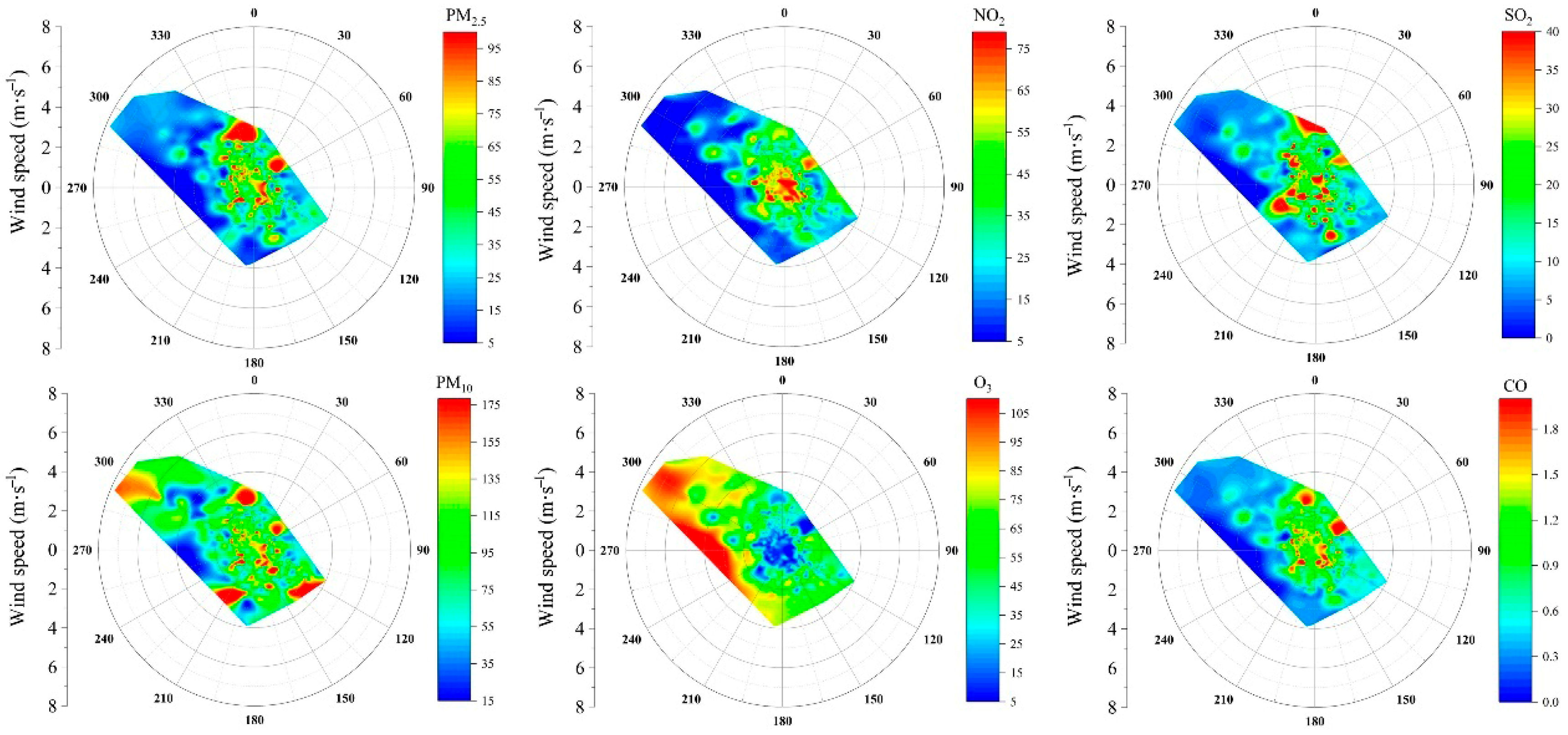
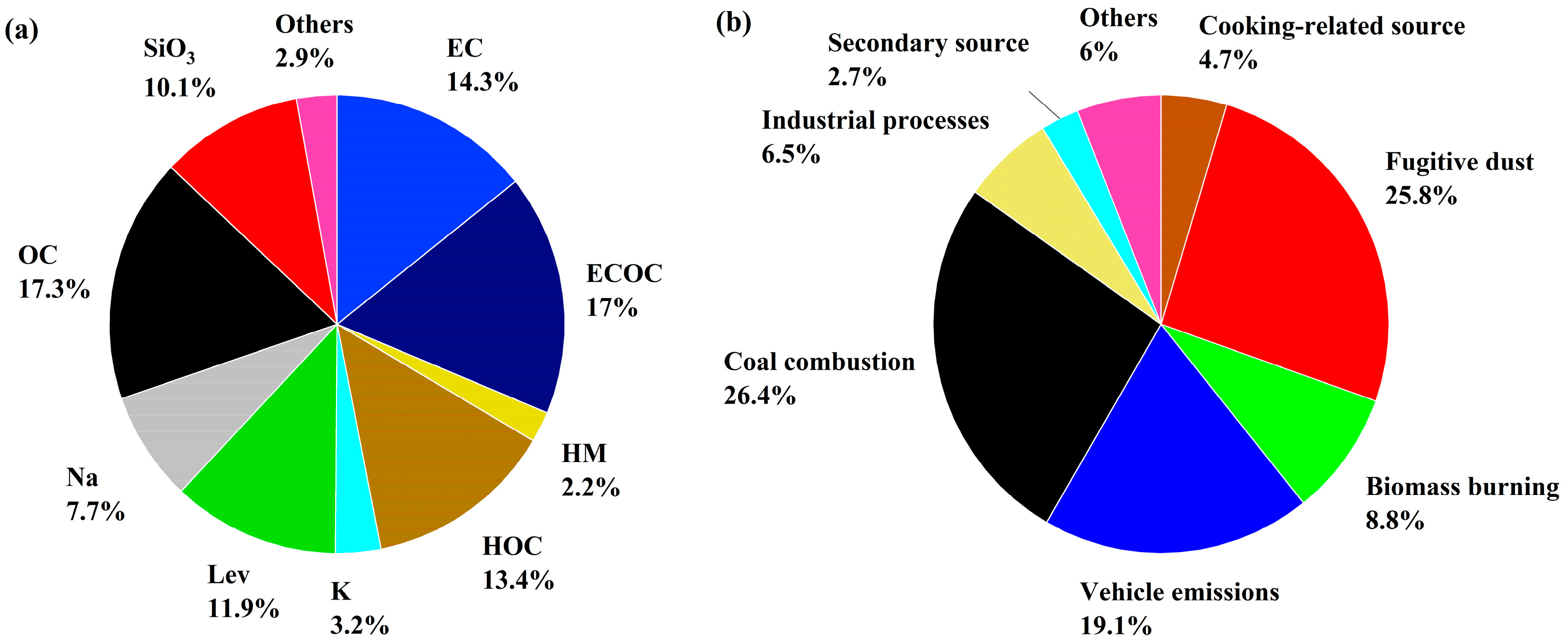
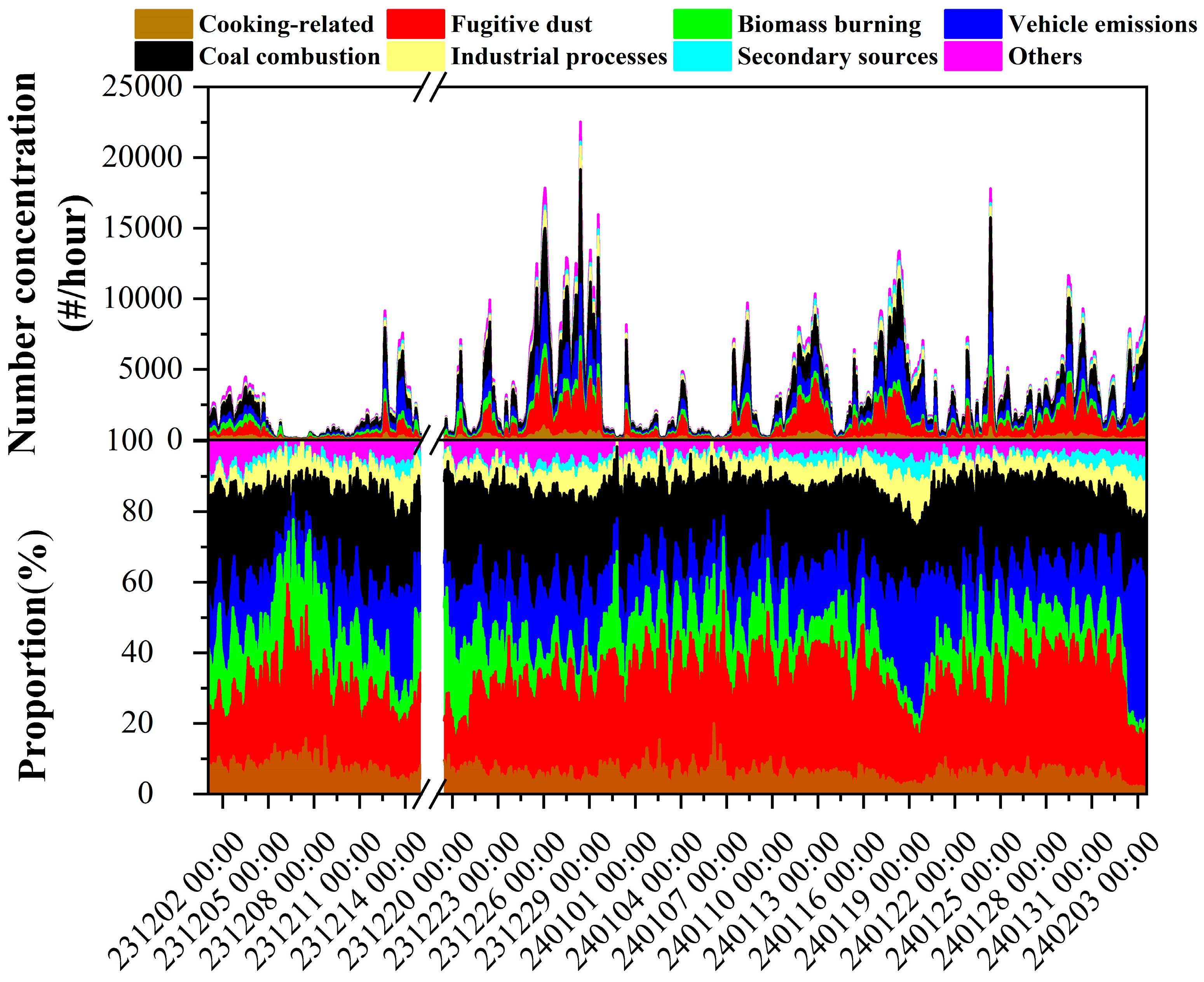

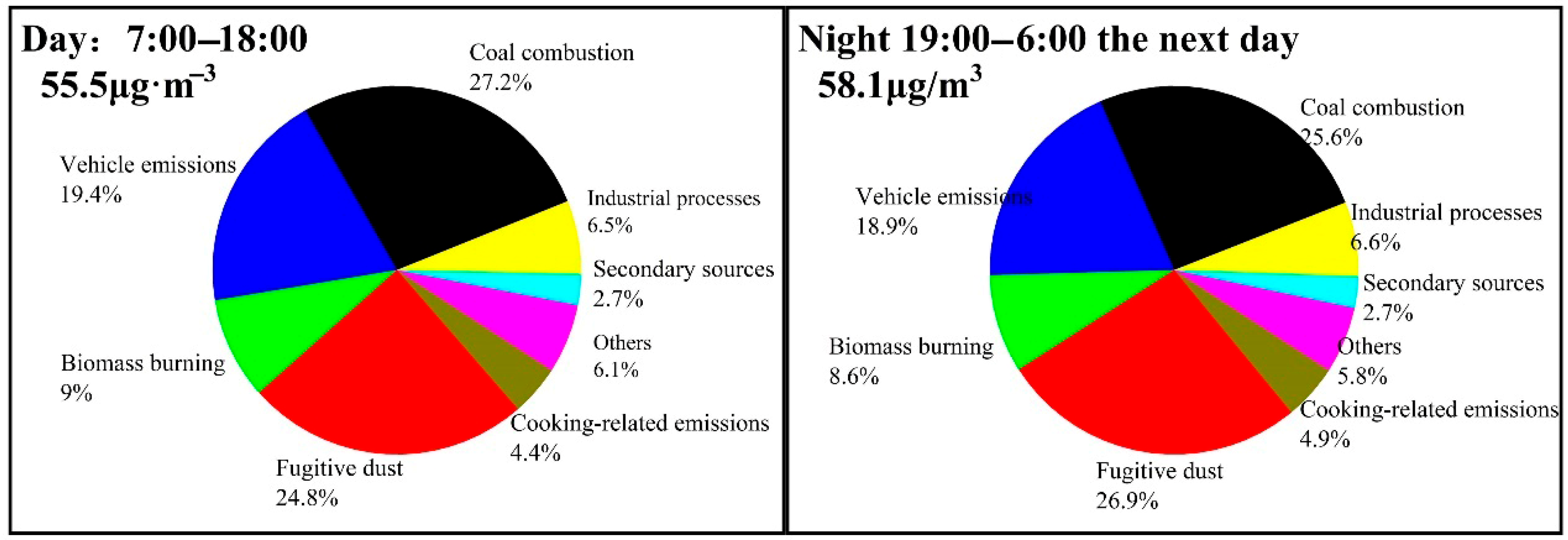

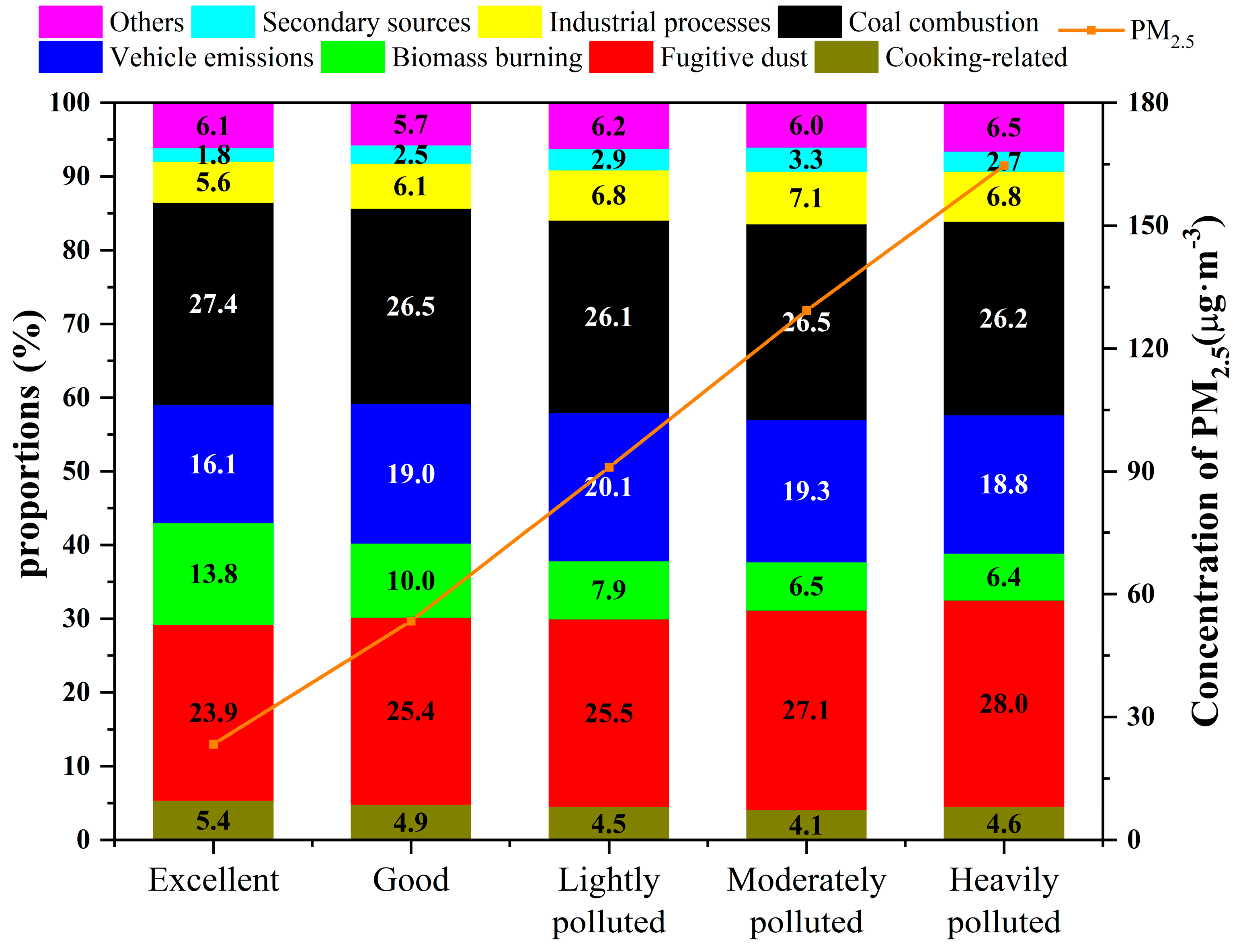
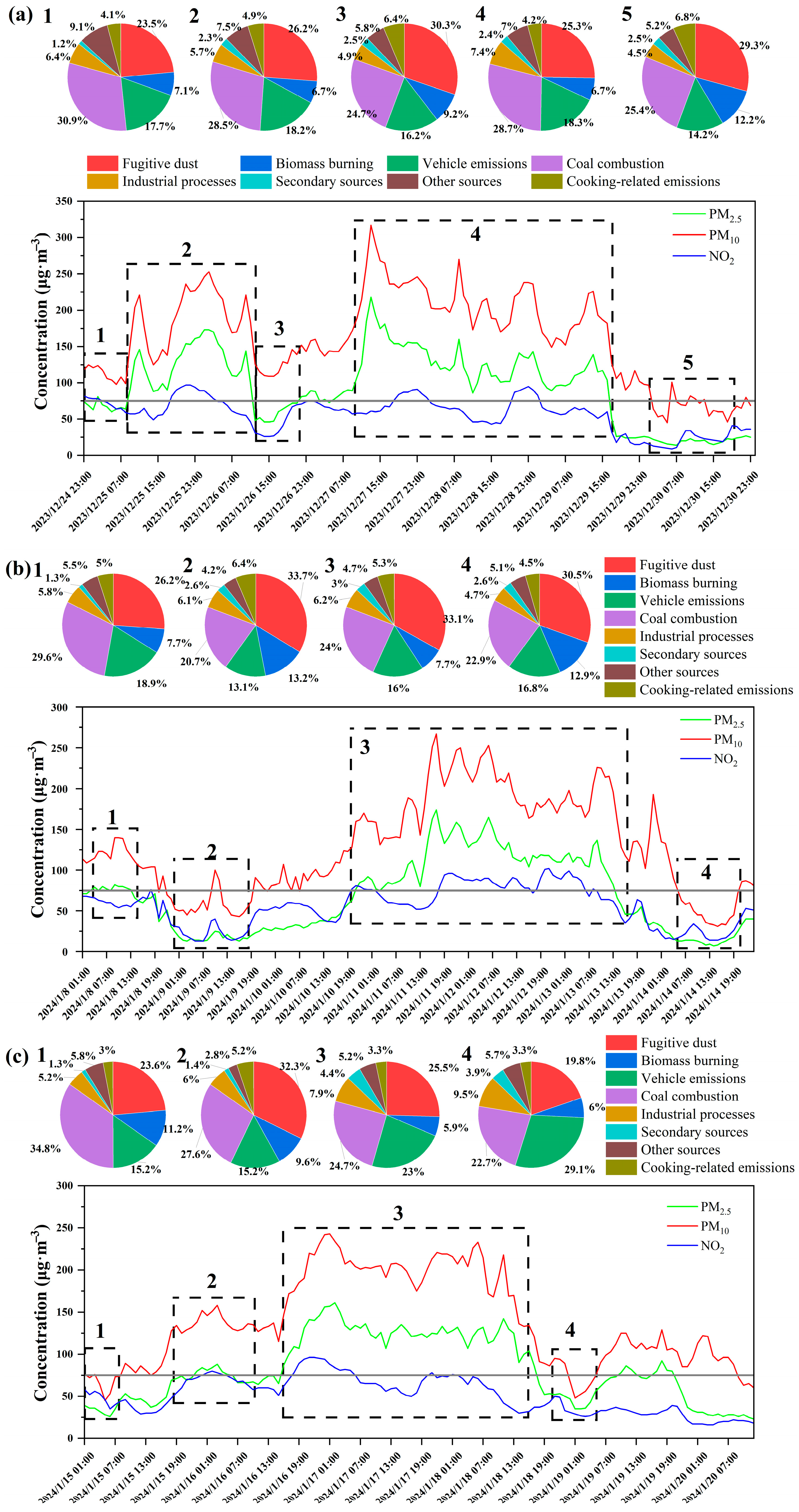

| Environmental Factors | Cooking | Fugitive Dust | Biomass Burning | Vehicle Emissions | Coal Combustion | Industrial Processes | Secondary Sources | Others |
|---|---|---|---|---|---|---|---|---|
| PM2.5 | −0.250 ** | 0.068 ** | −0.493 ** | 0.256 ** | 0.054 * | 0.188 ** | 0.267 ** | 0.057 * |
| PM10 | −0.134 ** | 0.093 ** | −0.346 ** | 0.135 ** | −0.008 | 0.180 ** | 0.238 ** | 0.020 |
| NO2 | −0.052 * | 0.168 ** | −0.299 ** | −0.098 ** | 0.239 ** | −0.065 * | −0.065 * | 0.070 ** |
| SO2 | −0.054 * | 0.353 ** | −0.230 ** | −0.096 ** | −0.007 | −0.096 ** | 0.131 ** | −0.164 ** |
| CO | −0.270 ** | 0.056 * | −0.492 ** | 0.153 ** | 0.235 ** | 0.127 ** | 0.118 * | 0.104 ** |
| O3 | 0.287 * | 0.176 ** | 0.363 ** | −0.094 ** | −0.501 ** | −0.087 ** | 0.183 ** | −0.251 ** |
| T | 0.274 ** | 0.264 ** | 0.139 ** | −0.043 ** | −0.564 ** | 0.159 ** | 0.266 ** | −0.226 ** |
| RH | −0.522 ** | −0.526 ** | −0.463 ** | 0.591 ** | 0.330 ** | 0.355 ** | 0.147 ** | 0.357 ** |
| WS | 0.171 ** | −0.024 | 0.284 ** | −0.066 * | −0.251 ** | 0.076 ** | 0.077 ** | −0.117 ** |
Disclaimer/Publisher’s Note: The statements, opinions and data contained in all publications are solely those of the individual author(s) and contributor(s) and not of MDPI and/or the editor(s). MDPI and/or the editor(s) disclaim responsibility for any injury to people or property resulting from any ideas, methods, instructions or products referred to in the content. |
© 2025 by the authors. Licensee MDPI, Basel, Switzerland. This article is an open access article distributed under the terms and conditions of the Creative Commons Attribution (CC BY) license (https://creativecommons.org/licenses/by/4.0/).
Share and Cite
Du, H.; Tan, T.; Pan, J.; Xu, M.; Liu, A.; Li, Y. Real-Time Source Dynamics of PM2.5 During Winter Haze Episodes Resolved by SPAMS: A Case Study in Yinchuan, Northwest China. Sustainability 2025, 17, 6627. https://doi.org/10.3390/su17146627
Du H, Tan T, Pan J, Xu M, Liu A, Li Y. Real-Time Source Dynamics of PM2.5 During Winter Haze Episodes Resolved by SPAMS: A Case Study in Yinchuan, Northwest China. Sustainability. 2025; 17(14):6627. https://doi.org/10.3390/su17146627
Chicago/Turabian StyleDu, Huihui, Tantan Tan, Jiaying Pan, Meng Xu, Aidong Liu, and Yanpeng Li. 2025. "Real-Time Source Dynamics of PM2.5 During Winter Haze Episodes Resolved by SPAMS: A Case Study in Yinchuan, Northwest China" Sustainability 17, no. 14: 6627. https://doi.org/10.3390/su17146627
APA StyleDu, H., Tan, T., Pan, J., Xu, M., Liu, A., & Li, Y. (2025). Real-Time Source Dynamics of PM2.5 During Winter Haze Episodes Resolved by SPAMS: A Case Study in Yinchuan, Northwest China. Sustainability, 17(14), 6627. https://doi.org/10.3390/su17146627






